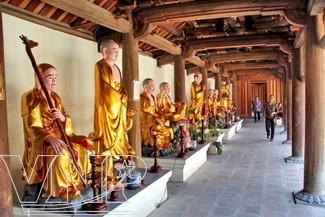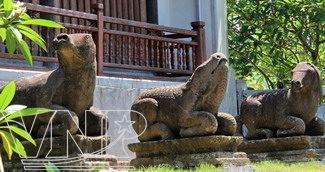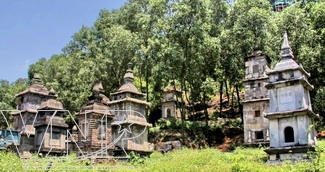Phat Tich or Van Phuc Pagoda is located on the southern side of Phat Tich Mountain, also known as Lan Kha Mountain, in Phat Tich Commune, Tien Du District, Bac Ninh Province. The ancient pagoda is famous for its beautiful architecture, serene landscape and sets of precious stone statues imbued with the sculptural art created during the Ly Dynasty.
The name of Phat Tich Pagoda is associated with a statue of the Buddha - a famous masterpiece. Legend has it that the tower of the pagoda suddenly collapsed and the statue came out amid the ruins. For this reason, the pagoda was given such a name and even Hoa Ke Hamlet located near the pagoda was renamed Phat Tich Hamlet.
As recorded in ancient documents, Phat Tich Pagoda was built in the 7th century. In 1066, King Ly Thanh Tong (1054-1072) ordered an exquisite Phat Tich tower built that was 40m in height on the southern side of Lan Kha Mountain. In 1947 the pagoda was destroyed by the French. Since 1954, the pagoda has been restored many times.

Phat Tich Pagoda is located on the southern side of Phat Tich or Lan Kha Moutain.

A statue of Amitabha Buddha, 1.85m high and dating from the Ly Dynasty, is considered a precious national object. |
According to researchers, the pagoda was built with the architecture of “noi cong ngoai quoc” (the internal shape looks like the Chinese character “gong” and the external shape looks like the Chinese character “quo”) with a stone veranda and stairs and walls that are decorated in the architectural style of the Ly Dynasty (1010-1225).
The pagoda now maintains a 7-space forecourt to receive guests, a 5-space Buddha worshipping hall and a 7-space Holly-Mother worshipping hall. At the rear of the pagoda is a garden with 32 towers of different sizes that were built with bricks and stones in the 17th century. Here, shariras of Buddhist monks are kept.

Statues of Arhats in Phat Tich Pagoda. |

The knife-shaped roof of Phat Tich Pagoda. |

Three of the ten statues of sacred stone animals in Phat Tich Pagoda. |

Tomb-towers in the garden of Phat Tich Pagoda. |
The pagoda still preserves a set of precious stone statues of the Ly Dynasty with a Buddha statue, 1.85m in height. It is the oldest one in the North and is considered a national treasure. This statue, carved out of stone, represents Buddha sitting in a meditation pose on a lotus throne. The pedestal is adorned with images of dragons, flowers and leaves. The face of the statue has refined features with an air of serenity and compassion. In 2006, the statue was recognized by the Vietnam Records Book Centre as the largest stone statue of the Ly Dynasty in Vietnam.
Among the remaining sculptures of the pagoda are five pairs of animal statues, including lions, rhinoceroses, elephants, buffaloes and horses, lying on lotus pedestals carved out of large stones that were also recognized as the largest stone animal pairs in Vietnam.
Also, many ancient sculptures during the Ly Dynasty with a great value in terms of art and history were found in the pagoda by archeologists.
Besides the landscape and architectural value, Phat Tich Pagoda is also famous for many historical legends that are closely attached to the pagoda. According to one legend, in 1071 King Ly Thanh Tong, on his visit to the pagoda, wrote a word “Buddhist” in Chinese script that was 5m in length and had it engraved on a stone stele to be set up on a mountain side. In 1129, King Ly Than Tong (1128-1138) ordered the construction of 84,000 earthen towers to place around the pagoda. In the Tran Dynasty in 1383, King Tran Nghe Tong organized a national examination right at the pagoda and there were 30 candidates who passed the examination.
With its historical and cultural values, in April 1962 the pagoda was recognized by the State as a national historical-cultural relic. At present, the pagoda is being restored to become one of the largest Buddhist cultural centres in the North.
Story: Vinh Hung - Photos: Trinh Van Bo